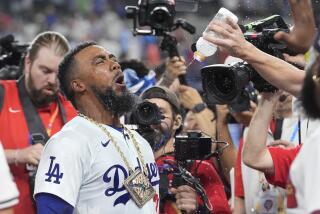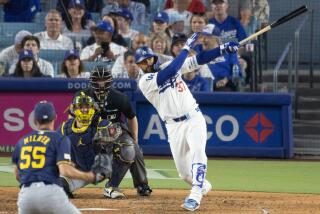Foxfield Derby Rides in an Exclusive League
They came from as far away as Napa Valley and Arizona to attend the exclusive jumping derby.
Professionals accustomed to competing in the World Cup, Grand Prix and Olympics came to ride against amateurs at the annual Foxfield Jumping Derby on Sunday at the Foxfield Riding School in Westlake Village.
The event has put the Conejo Valley bedroom community in an exclusive league.
Only a few derby competitions are held throughout the world each year. The oldest and most prestigious events are in Hickstead, England, and Hamburg, West Germany. The Foxfield derby is one of only two in the United States.
A jumping derby is different from traditional show-ring competitions because of the obstacles that are used. Derbies use logs, water, natural inclines and ditches, which are intermixed with the fence-type jumps that are found in show-ring events.
Show-ring contests are particularly popular on the East Coast, where winners can take purses as rich as $500,000. In California, prizes on the show-ring circuit often reach only $15,000.
Tim Postel, who designed the derby course and has run Foxfield Riding School with his family for 22 years, said the Westlake locale is unique because it has a permanently natural, woodsy environment that is required for derby competitions.
“There’s nothing else in California like it,” said Susan Hutchinson, winner of Sunday’s jumping derby, which was sponsored by a Westlake car dealer.
Hutchinson rode Rangoon, a Holsteiner horse from her home stable in La Canada Flintridge. In addition to a trophy, she won $2,000.
Hutchinson, who has been riding for 31 years, has been a member of the U. S. Equestrian Team and competed at the World Cup in Sweden and Paris. She said the uniqueness of the event is what draws her to compete at Foxfield, where she also won in 1982, 1983 and 1988.
That uniqueness attracted a crowd of parents, friends and sponsors Sunday. Many sipped wine and snacked on Brie while lounging under shady oaks and watching well-groomed horses--and well-groomed riders--maneuver through the obstacles.
The main event followed the Junior and Amateur Jumping Derby, sponsored by a Calabasas saddlery, which fielded 61 riders on 69 horses.
Julie Eldredge, 29, of Hollister won the event on her thoroughbred Rainmaker. Her prize was a $3,000 saddle, a trophy and $710 in cash. She said she has won jumping events at the Monterey national competition and the State Fair in Sacramento.
Thirty-eight riders competed in the main derby. Horses were eligible only if they had not placed fifth or better in any previous event offering more than $15,000 in prizes.
Hutchinson said because of this classification, the derby is more demanding for professional riders who are trying to give young horses experience in competition.
The triple combination, three fences in a row, proved to be the most troublesome obstacle.
Postel had put a water jump, which many horses are not familiar with, under the second fence to separate the well-schooled from the inexperienced. Most of the afternoon riders had no problem with the obstacle--although some of the junior riders took tumbles into the water.
In a derby, jumpers are judged in the first round on faults, which include refusals and the number of rails that are knocked down. Other factors, including riders or horses falling or exceeding the time limit, also are judged as faults.
In the last round, called a jump-off, the rider with the fastest time and least number of faults wins. The average rider completes the course in 90 to 120 seconds; horses typically cover the course at a speed of about 12 m.p.h.
Postel, who has been designing competition courses about 12 years, brought the derby to Foxfield because “I wanted to do something different that wasn’t being done everywhere on a weekly basis.”
He said the derby is a training ground for young riders hoping to become world-class competitors. The 24-jump layout has 4-foot-high obstacles for advanced horse-and-rider teams. Novices face 3-foot, 9-inch obstacles.
The variety of obstacles makes the course challenging for both horse and rider.
But for spectators, it’s just plain fun, Postel said.


